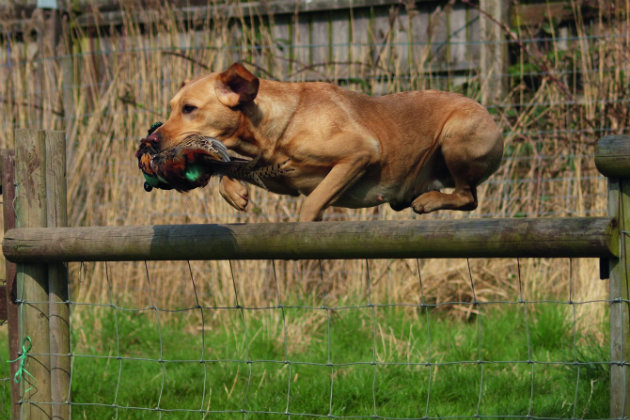Hip dysplasia in dogs
Before you choose a stud dog, find out whether it has been hip-scored

Labradors suffering from hip dysplasia are usually reluctant to jump
It’s many years since the dangers of hip dysplasia in dogs were first recognised. The British Veterinary Association (BVA) and the Kennel Club (KC) established their joint Hip Dysplasia Scheme in 1984 in a bid to try to understand the disease better, and to eradicate it from pedigree dogs. The scheme can hardly be called a failure, but neither has it been a success.
By now, you may have thought that a DNA test may have been developed, allowing us to recognise which dogs are carriers and which ones are not, but unfortunately hip dysplasia isn’t the sort of disease that allows such things.
Look at the way a dog moves
Visually, you can’t see that a dog has bad hips, though in many cases the animal’s posture will hint at the problem, and the way it moves will also be telling to anyone with a practised eye. It’s X-rays that reveal all. Hip dysplasia is a disease of the hip, caused by the malformation of the ball-and-socket joint. This means that the ball and the socket don’t fit together properly and, as a result, the joint rubs and grinds, instead of sliding with the silky smoothness that makes normal locomotion possible.
A dog with mild hip dysplasia might not be unduly inconvenienced, at least in its youth, but as it gets older the joint becomes worn, making it increasingly difficult, and painful, for the dog to move. Dogs do, of course, have two hips, so if one is perfect and the other slightly malformed, the dog may remain active well into old age. However, a dog with two bad hips might be crippled as a puppy.

High hip scores are a major cause of concern with Clumber spaniels
Hip dysplasia is not only an inherited problem
The real trouble with hip dysplasia is that, though it is regarded as an inherited problem, passed from sire or dam to their offspring, it’s not the result of a malformed gene, as is the case with such diseases as PRA (progressive retinal atrophy) or CM (centronuclear myopathy), both of which can be tested for. Vets will tell you that some breeds have a greater genetic predisposition to hip dysplasia than others, but they will also tell you that environmental factors play a role, too.
I remember reading an article by a researcher who was convinced that poor nutrition, or feeding the wrong diet, was as much to blame as anything.
Nor is hip dysplasia confined to dogs: it also affects humans. Here, the statistics reveal that it is 12 times more likely to occur where there is a family history of it. A similar rule applies to dogs. If you use a sire and dam that have good hips, the chances of the puppies suffering from hip dysplasia are much reduced, if not eliminated.
There’s no doubt that many gundogs suffer from bad hips, but because they have never been tested their owners are unaware of the problem. There are, however, numerous indications. Many of these are obvious, such as a dog’s reluctance to run or jump, or displaying lameness after a day’s shooting. An affected dog may stand with its back feet unnaturally closely together, or it may even develop more muscle in its shoulders as it tries to compensate for the lack of power in its hindquarters.

The BVA figures do not differentiate between show and working strains of dog, such as this cocker
Hip scoring is done by two vets
Having your dog hip-scored is the only way to know for certain the extent of the problem. It’s an expensive business, as the dog has to be sedated or anaesthetised by the veterinary surgeon for the X-ray to be taken — the dog has to be on its back with its hind legs fully extended. The X-rays,
or radiographs, have to be submitted to the BVA for evaluation, which costs £47.50.
Perhaps surprisingly, hip-scoring is done by the eye, always by two vets, well practised at looking at radiographs. Each hip receives a score from 0 (perfect) to a maximum of 53, with the scoring based on evaluation of nine separate features, using a set of defined criteria. The two vets have to agree the score. No dogs can be tested before their first birthday, and no dog can be tested more than once. Owners who can’t believe how badly their dog has scored can appeal, when the radiograph will be rescored by the chief scrutineer, whose decision is final.
Hip-scoring is a serious business: don’t forget that a potential stud dog, revealed to have poor hips, is unlikely to have the lucrative career he might have had otherwise. Under the BVA/KC scheme, the results of any registered dogs are sent to the KC, and you can check the figures on the KC website. It is also possible to have a non-registered dog tested, though the results won’t be published.
Hip scores for all registered breeds
The BVA publishes an average hip score for all the registered breeds. If you are looking for a stud dog, do make sure that it has hip scores well below the breed average. The average score varies widely from breed to breed, but it may also reflect the number of individuals that have been tested. It is worth remembering that the breed average is not the typical score for dogs of that breed, as it takes only a few individuals with high scores to affect the figure. Though the average for Labradors is officially 14, the majority of dogs have scores closer to 12.








